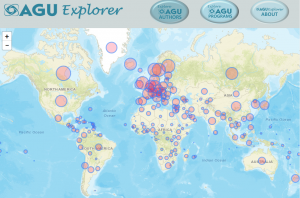With a goal of making the latest research in Earth and space science more discoverable, the American Geophysical Union (AGU) recently conducted a contest that awarded cash prizes to Earth and space scientists and software developers who found the most interesting new ways to visualize scientific papers, presentations, and data presented at AGU’s annual Fall Meeting. The winning entry is a new tool for exploring meeting abstracts by geographical location or scientific topic that was developed by two Oregon data scientists.
The AGU Open API Challenge encouraged participants to create new ways to expose and use data from the Fall Meeting, the world’s largest Earth and space science meeting. A software utility known as an application program interface (API) gave those taking part in the challenge controlled access to multiple sets of nonpersonal data from past Fall Meetings. The API, which was developed by AGU, provided access to data including abstracts, presenter information, and scheduling information from the 2014 to 2016 Fall Meetings as well as to available data from the upcoming 2017 Fall Meeting, which is to take place from 11 to 15 December in New Orleans.
The challenge: Create new ways to visually represent the depth and breadth of the research presented, find new ways for people to discover relevant research, explore new collaboration opportunities, or identify emerging areas of science.
Such a large amount of data is an invaluable resource, but on its own, “it wasn’t very easy to search,” said AGU meetings chair and head challenge judge Rick Murnane, an independent consultant for the World Bank regarding natural hazard risk assessments.
An essential part of the challenge was to open it to developers and scientists outside of the AGU community. Annie Burgess, one of the judges, emphasized the value of reaching outside our own circles: “Let’s see what others can come up with rather than continue to do the same thing.”
Judges were impressed by the submissions, and Murnane appreciated how people used pieces of existing open source software. “They moved beyond what they had in existing apps and leveraged it to their needs,” he said.
Burgess and Murnane both acknowledged that finding new ways to visualize data is a tall order, especially when the challenge asked participants to create something mobile friendly that could scale to mass use in such a short period of time. Nonetheless, “people rose to the challenge,” Burgess said.
The Winners!

A husband and wife team of science data analysts, Bennett Battaile and Meenakshi Rao of Portland, Ore., took first place with their app AGU Explorer. They used multiple visualization tools that give users new ways to see the data they’re sifting through. Their home page features a map that breaks down presentations by location. A nested pie chart page reveals meeting data progressively, presenting meetings, then topical areas, then sessions, and, finally, abstracts.
Placing second was AGU Analytics by Tom Narock, Sarah Hasnain, and Ronie Stephan of Notre Dame of Maryland University in Baltimore. They integrated various tools to help users discover emerging topics, relevant research, and new colleagues. Their keyword feature helps users identify new people and authors.
AGU Network captured the third-place honors. In this app by Gerry Rizzo of the University of Southern California, a network of lines interconnects data points, allowing users to explore Fall Meeting research and researchers that are related to one another.
Together, the teams won a combined $30,000 for their novel designs. Each team created interactive ways to navigate Fall Meeting data, and by visualizing those data differently, they may have also succeeded in helping AGU and future app users focus on new opportunities.
“If you can create ways to let people explore things or people that they don’t already know, maybe [they’ll decide] it’s time to go meet that person and collaborate,” said Burgess. “That opens a whole new door of discovery.”
Community Effort
AGU thanks everyone who participated in this first API Challenge for their continued contributions to science. We’d also like to thank our committed selection committee members and reviewers for taking the time to look through each application with careful thought and insight:
SELECTION COMMITTEERick Murnane, Head Judge, Chair of AGU Meetings Committee, Senior Disaster Risk Management Specialist, The World Bank Annie Burgess, Lab Director, Earth Science Information Partners Peter Brantley, Director of Online Strategy, University of California Davis Library Xiaogang “Marshall” Ma, Assistant Professor, Department of Computer Science, University of Idaho Suzan van der Lee, Associate Professor, Department of Earth and Planetary Sciences, Northwestern University |
REVIEWERSJohn Hammersley, CEO, Overleaf Sarah Ramdeen, recent Ph.D. graduate, School of Information and Library Science, University of North Carolina at Chapel Hill Liza Daly, Software Engineering Consultant Andrew Valentine, Fellow, Research School of Earth Sciences, The Australian National University Geoff McKenna, Oculus Group William Armstrong, Visiting Assistant Professor, Department of Geological and Environmental Sciences, Appalachian State University |
Just the Beginning
All three winning apps are now open to the public online. The apps are open source, allowing continued development on these projects. We plan to grow our API program in the future to include even more data sets, furthering our goal to transform our use of digital technology.
This exploration of data doesn’t end with the challenge. AGU sponsors or cosponsors other meetings such as the Ocean Sciences Meeting and small, single-topic Chapman meetings. “APIs can be [engineered] for all the different AGU meetings. It can be applicable to all sorts of meetings and maybe even shared with other societies,” Murnane said.
We are excited to see the benefits of our API and the opportunities created by the three winning apps. “Each challenge brings lessons learned,” Burgess said. “Getting people engaged and looking at the data themselves is a valuable process”—a process we expect will continue with use and further enhancement of these apps as well as with the next API data set and its app developers.
